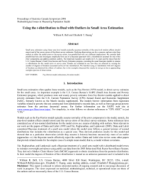
An official website of the United States government
Here’s how you know
Official websites use .gov
A .gov website belongs to an official government organization in the United States.
Secure .gov websites use HTTPS
A lock (
) or https:// means you’ve safely connected to the .gov website. Share sensitive information only on official, secure websites.
-
//
- Census.gov /
- Library /
- Census Working Papers /
- t-distribution to Deal with Outliers in Small Area Estimation
Using the t-distribution to Deal with Outliers in Small Area Estimation
Using the t-distribution to Deal with Outliers in Small Area Estimation
Abstract
Small area estimation using linear area level models typically assumes normality of the area level random effects (model errors) and of the survey errors of the direct survey estimates. Outlying observations can be a concern, and can arise from outliers in either the model errors or the survey errors, two possibilities with very different implications. We consider both possibilities here and investigate empirically how use of a Bayesian approach with a t-distribution assumed for one of the error components can address potential outliers. The empirical examples use models for U.S. state poverty ratios from the U.S. Census Bureau’s Small Area Income and Poverty Estimates program, extending the usual Gaussian models to assume a t-distribution for the model error or survey error. Results are examined to see how they are affected by varying the number of degrees of freedom (assumed known) of the t-distribution. We find that using a t-distribution with low degrees of freedom can diminish the effects of outliers, but in the examples discussed the results do not go as far as approaching outright rejection of observations.
Share
Related Information
Some content on this site is available in several different electronic formats. Some of the files may require a plug-in or additional software to view.
 Yes
Yes
 No
NoComments or suggestions?


Top

